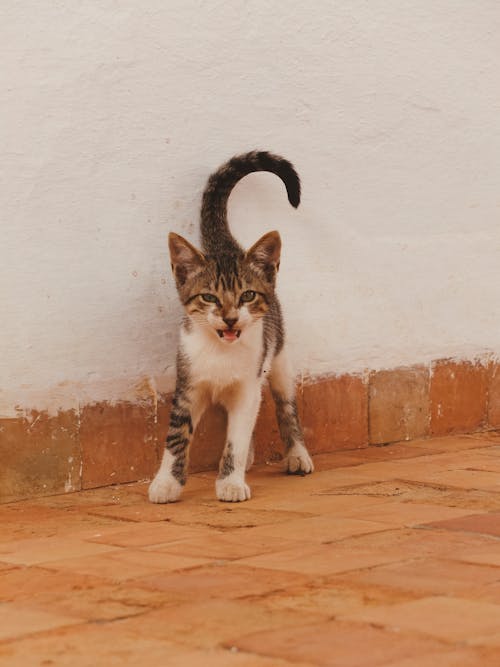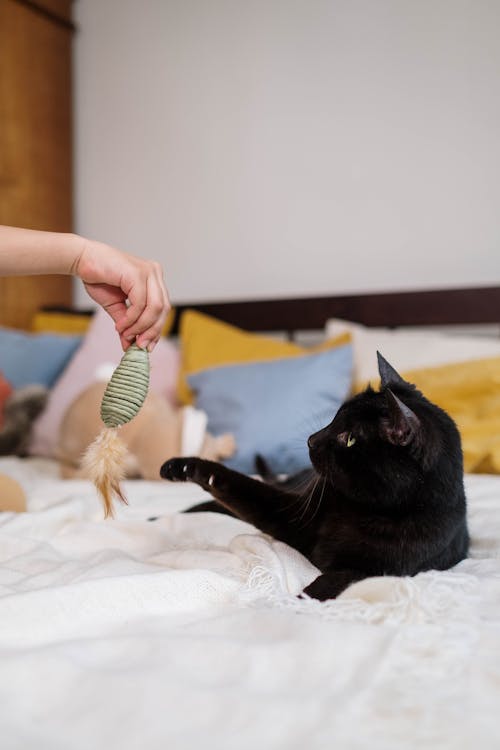The world of cat behavior is filled with intrigue and mystery, and one particularly fascinating action is when a cat uses its tail to slap its human companions. This behavior can leave many owners wondering about its meaning and whether their feline friends are simply looking to engage in play. Understanding the significance of a cat's tail movements can offer insight into its emotional state and intentions.

A cat's tail serves as a crucial form of communication, reflecting a range of feelings and intentions. The position and movement of a cat's tail can indicate excitement, curiosity, alertness, or fear, among other emotions. For instance, a tail held high often signifies confidence and happiness, while a drooping tail may suggest fear or insecurity. Cats also use their tails to signal playfulness, and a quick, slapping motion might indeed be an invitation to engage.
When a cat is excited or curious, you might observe its tail swinging back and forth vigorously. This is a clear sign that the cat is intrigued and potentially eager to explore whatever has captured its attention. In contrast, if a cat's tail is down and tucked, it usually indicates discomfort or a lack of confidence, often seen in unfamiliar environments. A raised tail often correlates with a state of alertness, signaling the cat's readiness to respond to whatever stimuli it encounters.
When your cat slaps you with its tail, it could very well be an indication that it wants to play. Cats are inherently playful creatures, and they utilize various means to capture their owners' attention. Slapping with the tail is just one of the many ways they may try to signal that they are in the mood for some fun. Along with tail slapping, cats often exhibit playful behaviors like jumping, chasing, and pouncing, which are all part of their natural instincts to engage with their surroundings.
Engaging in play is essential for a cat's overall health and well-being. It provides them with the necessary exercise to expend energy, keeping them fit and stimulating their minds. When you notice your cat slapping you with its tail, it is an excellent opportunity to join in the fun. Toys are a great way to interact, as cats often find small balls, feather wands, or even crumpled paper irresistible. Tossing a toy in your cat's direction can provoke a delightful chase, resulting in joyful moments for both you and your feline companion.
Another playful interaction involves setting up games that stimulate a cat's curiosity and hunting instincts. You can create a mini obstacle course using furniture or boxes, allowing your cat to explore and discover hidden toys. Engaging in such activities helps reinforce the bond between you and your cat while also providing mental stimulation.
The act of tail slapping may also stem from other emotional states. Sometimes, cats exhibit this behavior when they are excited or anxious, needing an outlet for their pent-up energy. If you notice your cat occasionally slapping its tail during a particularly intense play session or while observing something intriguing outside, it is likely a natural response to heightened feelings. However, it’s essential to be attentive to your cat’s overall demeanor. If the tail slapping seems excessive or is accompanied by signs of distress, it may indicate underlying anxiety or discomfort.
Cats are highly sensitive animals, and their emotional states can fluctuate based on various factors, including their environment and interactions with humans. If a cat is feeling threatened or overwhelmed, it may resort to tail slapping as a form of self-expression. Observing your cat's body language can offer crucial clues about how it is feeling at any given moment. Signs such as flattened ears, dilated pupils, or a tense body posture often accompany anxious behaviors, and these cues should not be overlooked.
Additionally, consider the importance of environmental comfort for your cat. Sometimes, a cat may feel uncomfortable due to changes in its surroundings, such as loud noises, unfamiliar guests, or other pets. Providing a safe, quiet space where your cat can retreat when feeling overwhelmed is essential. This environment allows your cat to feel secure, which can help reduce anxiety-related behaviors, including tail slapping.
When engaging with your cat, it is crucial to be mindful of its individual personality and preferences. Not all cats are equally inclined to play, and some may prefer a more relaxed approach to interaction. Pay attention to your cat's responses and adjust your activities accordingly. This sensitivity to your cat's needs fosters trust and strengthens your bond.
Understanding the reasons behind your cat's tail slapping can enhance your interactions and enrich your relationship. Whether it is a playful invitation or a sign of discomfort, being attuned to your cat's emotional state is vital. Engaging with your cat in ways that resonate with its natural behaviors and instincts not only supports its well-being but also brings joy to both of you. By taking the time to observe and respond to your cat's unique personality, you will create a rewarding and fulfilling companionship that flourishes over time.

As you continue to interact with your cat, it's important to keep in mind the nuances of feline behavior. Each cat has its own personality, and understanding these differences can greatly enhance the quality of your relationship. Some cats may exhibit a playful tail slap as a means of initiating fun, while others may be more reserved or prefer gentler forms of interaction.
Recognizing the context in which the tail slapping occurs can offer valuable insights. For instance, if your cat is playfully slapping you while in a relaxed position with its body language appearing loose and happy, it’s likely seeking engagement. On the other hand, if the tail slapping is accompanied by a tense body posture or an arched back, it might indicate that your cat is feeling threatened or anxious.
Creating a safe environment is key to ensuring your cat feels comfortable enough to express itself. Cats are territorial creatures, and they thrive in spaces that allow them to feel secure. Make sure your cat has access to cozy hiding spots and elevated perches where it can observe its surroundings without feeling exposed. This will not only help reduce stress but also encourage your cat to be more open during playtime.
You can also enhance your cat's play experience by incorporating variety into your interactions. Using different types of toys can keep your cat engaged and stimulate its hunting instincts. For example, laser pointers can provide a fun chase, while feather wands allow for interactive play that mimics the movements of prey. Rotating toys regularly can prevent boredom, keeping your cat intrigued and excited during play sessions.
Furthermore, consider incorporating structured playtime into your routine. Just as dogs benefit from daily walks, cats need time to exercise and engage in play to maintain their physical and mental health. Establishing a regular schedule for playtime can help your cat understand when it can expect interactive sessions with you, making it more likely to initiate play through behaviors like tail slapping.
Another aspect to consider is the importance of positive reinforcement during your interactions. Rewarding your cat for engaging behaviors—such as responding to your calls or playfully slapping with its tail—can reinforce these actions. Offering treats or praise when your cat approaches you or engages with toys can create a positive association with playtime. This approach encourages your cat to be more forthcoming in its attempts to engage with you.
Monitoring your cat’s health is also crucial, as physical discomfort can lead to changes in behavior, including increased tail slapping or signs of irritability. Regular veterinary check-ups are essential to ensure your cat is in good health, especially as it ages. Pay attention to any changes in appetite, activity levels, or litter box habits, as these can signal potential health issues. Addressing any underlying concerns can help maintain your cat's overall well-being and allow for a more enjoyable interaction.
Understanding that your cat's tail slapping behavior can stem from various motivations—playfulness, anxiety, or a desire for attention—can help you respond appropriately. If your cat appears to be in a playful mood, engaging with it through interactive play can strengthen your bond and provide an outlet for its energy. On the other hand, if your cat seems anxious or agitated, offering a calm environment and giving it space may be the best course of action.
Ultimately, building a strong relationship with your cat requires patience, observation, and an openness to understanding its needs. By paying attention to the subtle cues your cat provides, you can foster a deeper connection and ensure both you and your feline friend enjoy a happy and fulfilling companionship. Whether it’s through playful tail slapping or gentle nuzzles, every interaction holds the potential for joy and connection. Your cat's unique personality adds to the richness of your shared experiences, making every moment spent together worthwhile.

Additionally, creating a stimulating environment can significantly impact your cat's behavior and overall happiness. Cats are natural hunters, and providing opportunities for them to engage in their instinctual behaviors is essential for their mental and physical well-being. Consider incorporating scratching posts, climbing trees, and interactive toys that challenge your cat and encourage active play. These items can help fulfill their need for exploration and can lead to less unwanted behavior, such as tail slapping or other attention-seeking actions.
Another effective method to enrich your cat's environment is through puzzle feeders. These feeders encourage your cat to think critically and work for their food, mimicking the hunt and providing mental stimulation. By engaging your cat in these activities, you not only keep them entertained but also prevent boredom, which can sometimes lead to destructive behavior. A busy cat is a happy cat, and a happy cat is less likely to engage in attention-seeking behaviors, including tail slapping.
Socialization also plays a crucial role in your cat's behavioral development. Exposing your cat to different people, animals, and experiences can help them become more confident and well-adjusted. If you have other pets, introducing them gradually can create a more harmonious household and allow for shared play opportunities. Cats often learn from observing each other, and a confident, playful cat can inspire a more reserved feline to engage in playful behavior.
Understanding your cat's body language during these social interactions is just as important. Cats communicate a lot through their posture, ear position, and tail movements. For example, a cat with a puffed-up tail may be feeling threatened, while a cat with a relaxed tail is likely comfortable and at ease. Being able to read these cues can help you better understand your cat's emotions and tailor your interactions to suit its needs.
When considering playtime, it’s essential to acknowledge that not all cats have the same preferences. Some cats may enjoy vigorous play, while others may prefer gentle interaction. Offering a variety of toys, such as soft stuffed animals or interactive laser toys, allows your cat to choose how it wants to play. Observing which toys your cat gravitates toward can give you insight into its personality and preferences, leading to more meaningful play sessions.
As you engage with your cat, remember that patience is key. Training and building a connection with your feline companion takes time, and there will be moments of trial and error. If your cat seems hesitant or unresponsive to certain activities, it’s essential to adjust your approach and find what works best for your unique pet. The more you invest in understanding your cat's behaviors and preferences, the more rewarding your relationship will become.
Furthermore, consider the importance of routine. Cats thrive on consistency, and having a structured daily schedule can provide a sense of security. Regular feeding times, play sessions, and quiet time can help your cat feel more at ease in its environment. This routine can also help your cat know when to expect interaction and when it’s time to relax, reducing anxiety and promoting a sense of stability.
In moments of uncertainty or behavioral changes, never hesitate to consult with a veterinarian or a feline behaviorist. These professionals can provide valuable insights into your cat’s behavior and health, helping you navigate any challenges that arise. Understanding the underlying causes of behavior, whether physical or psychological, can equip you with the tools necessary to foster a healthier, happier cat.
Engaging with your cat through play, understanding its body language, and providing a stimulating environment are all critical components of nurturing a positive relationship. The more you learn about your cat and respond to its needs, the stronger your bond will become. Every tail slap can be seen as an invitation, a call for attention, or a playful gesture, and embracing these moments can lead to joyful experiences for both you and your feline friend.
Your journey with your cat is filled with opportunities for connection, learning, and love. By being attentive to your cat's behavior and emotions, you can create a home where both of you thrive, fostering a deep, enduring companionship that enriches your lives. So the next time your cat gives you a playful tail slap, take it as a sign of affection and an invitation to engage in the delightful dance of play and connection.
